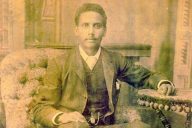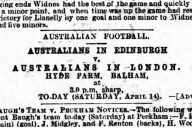It’s a freezing Saturday afternoon in June at Trevor Barker Oval and the Zebras faithful wait for their team to run onto the field to greet the howling Port Phillip Bay wind.
The side has had a solid start to the year, winning eight of its first 12 games and is confident.
Confident while fully aware of its opponents for the day.
After running through the banner, Sandringham jog over to the city-end of the famous Beach Rd ground, which has recently seen a multi-million dollar upgrade.
After a lull in cheers from the 14,000-strong crowd, the black and white army launches its banner into the sky. The Pies charge through with determined looks on their faces.
They are still trying to come to terms with their recent relegation just eight years after taking out the 2010 AFL premiership…
What if?
This probably won’t happen, but humour me and imagine one possible, unrealistic future for Australian Rules football.
I am in no way claiming the conception of this idea. Many have talked about this before. I just want to put forward my version of a potential two-tiered AFL system.
The standard and professionalism of Australian Rules has grown in leaps and bounds in just a decade. Not just in the premier competition but the various state leagues, including the West Australian Football League, South Australian National Football League, Tasmanian State League and North East Australian Football League.
What if the existing 18-team league competition was maintained but a second 14-team division was added by taking teams from every state to compete against each other?
This wouldn’t be hard and fast, but perhaps three from each of the VFL, SANFL and WAFL, as well as two from the TSL and three from the NEAFL, which includes Northern Territory Thunder.
So you’d have, for example, Sandringham, Port Melbourne and Williamstown from Victoria. The remaining VFL teams would continue on in the VFL and would still be feeder clubs to the AFL.
Those three from Victoria could be joined by Norwood, Central Districts and Glenelg from South Australia; Claremont, East Perth, Swan Districts from Western Australia; Launceston and Hobart from Tasmania; Belconnen from New South Wales; Southport from Queensland; and the NT Thunder.
At the end of the season, the second division grand finalists would be promoted to the premier competition, while the two lowest placed first division sides would be relegated.
Why do it?
It inspires a romantic vision of the game just like the one discussed in the introduction. The potential for Hawthorn to take on NT Thunder, Southport hosting Carlton, Claremont dueling with Richmond, Hobart battling Brisbane and Glenelg up against St Kilda – all for premiership points.
It raises the profile and following of the sport for fans that prefer to watch their local team rather than align with an AFL franchise. For example, those fans who prefer to watch Port Melbourne over North Melbourne. It could conceivably strengthen the professional game’s links to its grass-roots.
It also brings to the sport an element of the tension and excitement seen each year in those epic relegation and promotion battles fought in the English Premier League and Championship.
It gives more players the chance to compete at the top level, as any young side that wins the second division flag will be in the running to ply their trade on the MCG on the last Saturday in September the next year. It will boost tourism for regional areas and give rise to boutique stadiums across the country.
However, like with most things in life, money proves the biggest hindrance for this to become reality. The AFL would be extremely unlikely to ever let this happen, chiefly because of money. Money would have to be spent fixing up these boutique stadiums to make them ready for larger crowds.
Lower levels clubs would need financial assistance to help them boost their facilities, pay their players professional salaries and jet them across the country almost fortnightly to play away games.
It would also have to factor in a likely drop in attendance revenue if a Collingwood, Carlton or Essendon dropped a division. While supporters might deny it, many would be unlikely to attend smaller stadiums to watch their team play in the second division.
There is also the issue of clubs like Melbourne, the Bulldogs and North Melbourne, all of which are trying to keep their respective heads above water. Because, let’s face it, supporter levels are already spread pretty thin.
But part of me thinks a team could take a lot more from winning games at the top of a second division and breeding a winning culture, than floundering at the bottom of the first division season after season.
Recruitment would be the other issue. How do you run a draft when teams are bouncing between divisions? Do you even have a draft anymore? And if you got rid of the draft and adopted a free agency system would the AFL end up with a similar power structure to the EPL – top heavy with four or five rich clubs lording it over the smaller clubs?
There’s no perfect answer, but…
One option would be to go to back in time and scrap the draft altogether.
In the “old days” teams had designated recruitment zones, Melbourne’s suburbs were allocated to each club: Bulleen was Fitzroy, Glen Waverley was Richmond, Frankston was St Kilda, etc.
This system might give all 32 teams the chance to pick up the best player in the league. And if they know the next big player is in their area when they actually need older bodies for a run at a premiership, they can trade the rights to that young star for older more established players.
Free agency would be essential under this system. Teams would have the same salary cap and could lure players across divisions for the right price.
The other less likely system would be to run an NBA-like lottery system where the poorer performing teams in each division would have a higher chance at winning the first pick.
This system is flawed because we are now dealing with the 32 teams in a draft. By the end of the first round most of the talent would be gone and could, by chance, have gone to teams in only one division.
Would people still watch?
We also need to consider television rights and scheduling. Fox Footy is already covering nine games a week. Free-to-air shows four. The ABC could extend its VFL association by taking up the rights to a few second division matches each week.
I can tell you this, when foundation clubs start playing second division, there will still be television interest – have a look at how Scotland’s Rangers FC continues to have its matches covered even though it plays in the third-tier competition. Carlton, Collingwood and Essendon would likely still attract eyeballs for their matches.
When it comes down to it, the league has tampered with the game too much in recent years, so I don’t think a change as massive as the institution of a second division is in the offing.
But the AFL wants to grow the game. And for that to happen, you need to engage more people. Whether there’s enough playing talent to fill the void remains to be seen, but there’s some merit to the idea of a second division.
This is obviously a far from flawless theory. But it might be a growth path the AFL will seriously have to look at one day, possibly soon.
















